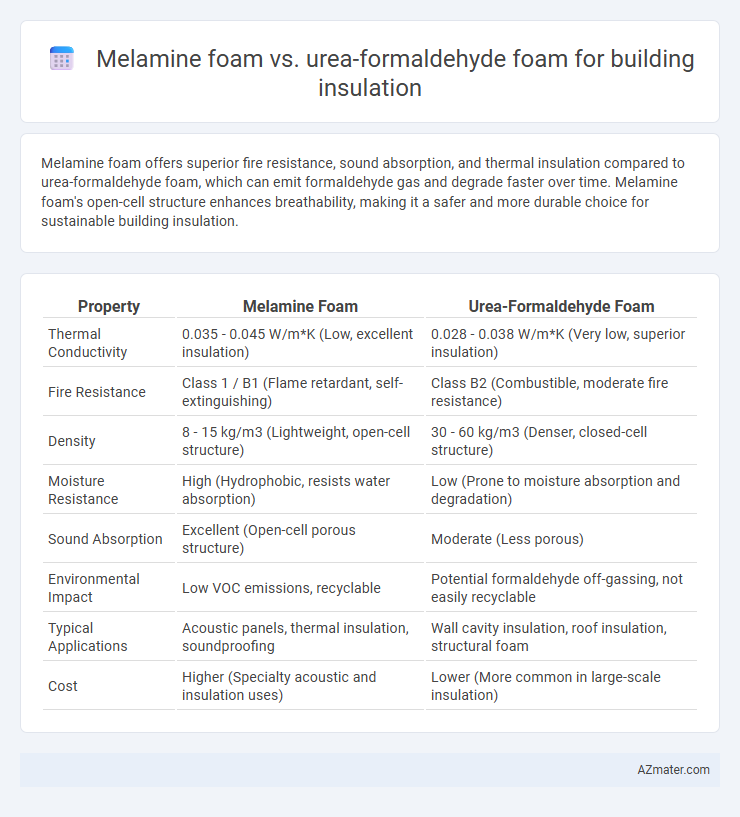Melamine foam offers superior fire resistance, sound absorption, and thermal insulation compared to urea-formaldehyde foam, which can emit formaldehyde gas and degrade faster over time. Melamine foam's open-cell structure enhances breathability, making it a safer and more durable choice for sustainable building insulation.
Table of Comparison
| Property | Melamine Foam | Urea-Formaldehyde Foam |
|---|---|---|
| Thermal Conductivity | 0.035 - 0.045 W/m*K (Low, excellent insulation) | 0.028 - 0.038 W/m*K (Very low, superior insulation) |
| Fire Resistance | Class 1 / B1 (Flame retardant, self-extinguishing) | Class B2 (Combustible, moderate fire resistance) |
| Density | 8 - 15 kg/m3 (Lightweight, open-cell structure) | 30 - 60 kg/m3 (Denser, closed-cell structure) |
| Moisture Resistance | High (Hydrophobic, resists water absorption) | Low (Prone to moisture absorption and degradation) |
| Sound Absorption | Excellent (Open-cell porous structure) | Moderate (Less porous) |
| Environmental Impact | Low VOC emissions, recyclable | Potential formaldehyde off-gassing, not easily recyclable |
| Typical Applications | Acoustic panels, thermal insulation, soundproofing | Wall cavity insulation, roof insulation, structural foam |
| Cost | Higher (Specialty acoustic and insulation uses) | Lower (More common in large-scale insulation) |
Introduction to Building Insulation Materials
Melamine foam offers superior fire resistance, thermal insulation, and sound absorption compared to urea-formaldehyde foam, making it suitable for high-performance building insulation applications. Urea-formaldehyde foam, while cost-effective and providing decent thermal insulation, poses issues related to formaldehyde emissions and lower moisture resistance. The choice between melamine foam and urea-formaldehyde foam depends on criteria such as fire safety standards, indoor air quality, and environmental impact in building insulation projects.
Overview of Melamine Foam
Melamine foam is a lightweight, open-cell material known for its excellent thermal and acoustic insulation properties, making it highly suitable for building insulation applications. This foam exhibits superior fire resistance and low smoke emission compared to urea-formaldehyde foam, enhancing safety in residential and commercial structures. Its high noise absorption coefficient and effective thermal insulation contribute to improved energy efficiency and enhanced indoor comfort.
Overview of Urea-Formaldehyde Foam
Urea-formaldehyde foam insulation (UFFI) is a synthetic polymer made by reacting urea and formaldehyde, commonly used in building cavities due to its high thermal resistance and cost-effectiveness. Its closed-cell structure provides effective air sealing and moisture resistance, although concerns about formaldehyde off-gassing have limited its application in modern construction. UFFI offers good fire resistance and soundproofing properties but requires proper installation to avoid potential health issues associated with formaldehyde emissions.
Thermal Insulation Performance Comparison
Melamine foam demonstrates superior thermal insulation performance compared to urea-formaldehyde foam due to its lower thermal conductivity, typically around 0.033 W/m*K, which enhances energy efficiency in buildings. Urea-formaldehyde foam generally has a higher thermal conductivity ranging from 0.038 to 0.040 W/m*K, resulting in slightly reduced thermal resistance. The open-cell structure of melamine foam also provides better breathability and moisture regulation, contributing to improved indoor comfort and insulation longevity.
Fire Resistance and Safety Aspects
Melamine foam demonstrates superior fire resistance compared to urea-formaldehyde foam, as it is inherently fire-retardant and does not emit toxic gases during combustion. Urea-formaldehyde foam poses higher safety risks due to its propensity to release formaldehyde, a hazardous volatile organic compound, especially when degraded by heat. Building insulation using melamine foam offers enhanced safety by reducing flammability and toxic emissions, making it a preferred choice for fire-sensitive applications.
Durability and Longevity
Melamine foam offers superior durability for building insulation due to its high resistance to compression, moisture, and microbial growth, ensuring long-lasting performance in various environmental conditions. In contrast, urea-formaldehyde foam tends to degrade faster over time, particularly when exposed to moisture, which can lead to reduced insulation effectiveness and potential structural damage. Choosing melamine foam enhances the longevity of insulation systems by maintaining thermal efficiency and structural integrity over extended periods.
Environmental Impact and Sustainability
Melamine foam offers a lower environmental impact compared to urea-formaldehyde foam due to its non-toxic composition and recyclability, reducing harmful emissions during manufacturing and disposal. Urea-formaldehyde foam, while effective for insulation, releases formaldehyde gas, a known carcinogen, contributing to indoor air pollution and environmental degradation. Sustainable building projects increasingly favor melamine foam for its biodegradability and reduced carbon footprint, aligning with green construction standards and long-term ecological benefits.
Health and Indoor Air Quality Considerations
Melamine foam offers superior health benefits over urea-formaldehyde foam due to its low emission of volatile organic compounds (VOCs), which enhances indoor air quality and reduces risks of respiratory irritation and allergic reactions. Urea-formaldehyde foam insulation releases formaldehyde gas, a known carcinogen linked to asthma and other respiratory issues, making it less suitable for environments prioritizing occupant health. Selecting melamine foam aligns with stringent indoor air quality standards and promotes safer living spaces by minimizing harmful chemical exposure.
Installation Processes and Practicality
Melamine foam offers superior ease of installation due to its lightweight, flexible structure that can be easily cut and shaped on-site, enabling rapid application in irregular spaces without specialized equipment. Urea-formaldehyde foam requires precise mixing and spraying techniques, often necessitating professional handling to ensure proper expansion and cure, which can complicate installation in existing buildings. In practical terms, melamine foam's fire-resistant and moisture-resistant properties enhance long-term performance and reduce maintenance, whereas urea-formaldehyde foam may emit formaldehyde gases and degrade over time, impacting indoor air quality and durability.
Cost Analysis and Economic Feasibility
Melamine foam typically incurs higher initial costs compared to urea-formaldehyde foam due to its advanced fire-resistant properties and superior thermal performance, which can lead to long-term energy savings. Urea-formaldehyde foam remains a more cost-effective option upfront, favored in budget-sensitive projects despite concerns over formaldehyde emissions and lower fire resistance. Economic feasibility studies often highlight melamine foam's advantage in lifecycle cost reduction through enhanced durability and insulation efficiency, making it suitable for high-performance building insulation despite the steeper investment.

Infographic: Melamine foam vs Urea-formaldehyde foam for Building insulation
 azmater.com
azmater.com